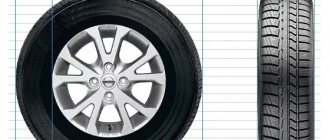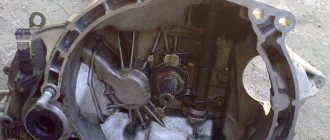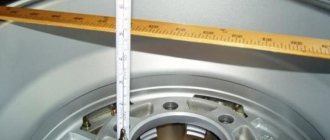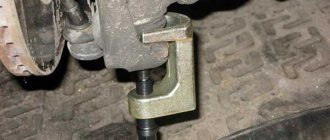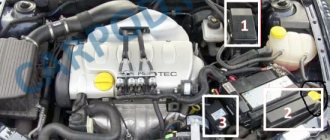Second generation Samara cars are found on the roads all the time. Most of them are in poor condition, but there are also examples that have been seriously modified by external tuning. An integral part of a well-maintained “four” is casting instead of stamped discs. Stylish wheels improve the appearance of the car several times. Even an ordinary VAZ 2114 in casting with the right style attracts attention.
What is a catalyst
A catalyst is needed in order to reduce the emission of harmful substances into the atmosphere.
It burns exhaust gases. Most car owners, as a rule, do not care whether the exhaust from their car is harmful or not. If you are interested in the catalyst, it means that it is either clogged, or you want to install a spider, or you are getting an error. Usually the catalyst lasts no more than 100 thousand km. After this, it will be almost completely clogged. Although, if you fill in low-quality gasoline, you can ruin it much earlier.
Installation procedure
- We install the flywheel in the reverse order in accordance with the mark made during disassembly. Before tightening the flywheel mounting bolts, apply thread locker to their threaded part. The flywheel must be installed on the crankshaft in only one position. If the mark made has been erased, the flywheel can be installed on the shaft according to the factory mark - for this purpose, a hole is drilled on the outside of the flywheel. When installing the flywheel on the crankshaft, the mark should be located opposite the crankpin of the fourth cylinder. Do not confuse the mark with the balancing holes, which are made with a larger diameter drill
Breakdowns and their signs
Typically, this element begins to “strange” when it travels about 150 thousand kilometers. That is, this is more likely an age-related problem with the car.
Standard and Modified
Typical signs that the catalyst is clogged are:
- The car's dynamics deteriorate significantly and noticeably;
- The engine starts with problems;
- There is a characteristic smell of sulfur in the cabin;
- The engine is unstable at idle.
SYMPTOMS OF MALFUNCTION
Over time, this mechanism becomes unusable and requires repair or replacement. Typically, a VAZ 2114 catalyst can operate for about 150 - 200 thousand kilometers. After this, the filler becomes so clogged that exhaust gases cannot penetrate through them. You can determine that this mechanism is faulty by a number of characteristic symptoms.
The first thing that becomes noticeable, even when the catalyst is working, but already in its critical condition, is a sharp deterioration in dynamics. For example, acceleration to 100 km/h, instead of 13 seconds, will take 17 - 20, and the free wheeling will practically disappear.
The second sign is unstable idle speed. Due to the fact that the purifier will be practically clogged, some of the exhaust gases will return to the combustion chamber. Since the engine does not generate pressure at idle speed, the reverse flow of gases will simply “choke” it.
The third sign is deterioration in engine starting. Since exhaust gases will not exit through the exhaust pipe, they will remain in the system even when the car is not running. Therefore, when you try to start the engine, the gases will mix with fuel fumes, and a fire will not occur.
And the last, fourth sign is a distinct smell of sulfur in the car interior. Since the exhaust gas removal mechanism passes through the entire car, if it is clogged, gases will penetrate into the ventilation cracks, polluting the interior of the car.
Replacement for an 8-valve engine
Device option for eight-valve
Some believe that instead of a failed filter device, you can install a regular corrugated pipe . Also a wrong decision. This will make the noise incredibly loud, and the exhaust gases will very quickly destroy the muffler. You can get by with a budget replacement option - cut out a section of the catalyst, knock out a honeycomb of ceramics from it and perform welding, thereby sealing the body. But be prepared for noise to become your constant companion.
It is best to replace the factory catalyst with an effective flame arrester. They assemble it with their own hands or seek help at a service station, and also purchase ready-made solutions at auto parts stores. Whichever option suits you best, choose that one.
Removing the unit and replacing it with another device is a matter of one hour. At the same time, there is no need to worry about electronics. There is only one oxygen sensor, and it is installed before the catalyst. Therefore, replacing it with a flame arrester will not affect the measurement readings in any way.
Replacement on a 16-valve engine
In the case of a 16-valve power unit, the catalyst is included in the design with the output manifold. Therefore, look for it behind the cylinder block directly in the engine compartment.
The nuance of dismantling the 16-valve engine is the presence of two lambdas.
- The first is located directly on the catalyst. It serves to adjust the fuel mixture;
- The second is located on the flange after the device. It is called ecological. If this lambda is not in place, the sensor will immediately generate an error, the injection will stop working properly, thrust will increase and fuel consumption will increase.
There are two ways to solve this issue:
- If you bought a spider for one regulator, the electronic control unit can be upgraded to Euro 2 from the current Euro 3. But such a spider has a serious drawback - the only thread for the lambda is on the flange. To mount the injection lambda there, you will have to assemble an extension cord from a wire and two connectors, called mother-father.
- If it is a spider with two regulators, the injection lambda is mounted in a standard socket. The thread for the second sensor is plugged or a dummy for the electronic control unit is installed in its place. In the second situation, there is no need to reflash the ECU.
Withdrawal procedure
- Remove the clutch pressure and driven discs.
- Using any available method, we mark the position of the flywheel on the shaft.
Using a 17 mm socket wrench, unscrew the six bolts securing the flywheel, holding it from turning with a mounting blade or screwdriver, resting it against the protrusion of the cylinder block.- Remove the washer and flywheel.
- If necessary, remove the upper cover of the clutch housing from the guide bushings.
Popular myths
Varieties
Some people deliberately get rid of the catalyst, others deliberately ignore the clogged unit. All this caused the spread of myths.
- By removing it, the engine gains power. A misconception that arose for unknown reasons.
- The engine cannot “breathe” normally due to the catalyst. Absurd. It functions quite well if the cat itself is in working order.
- A clogged element ensures a more environmentally friendly ride. Another myth, the origin of which can only be guessed at. Rather, on the contrary, a clogged device harms nature and your car even more.
Therefore, monitor the condition of the catalyst on the VAZ 2114, check its functional condition, and if necessary, replace it with a new one or replace it with a flame arrester. Both options have shown their effectiveness.
In the context of the fight for the environment, car manufacturers are coming up with more and more sophisticated ways to reduce harmful emissions into the atmosphere, thereby preventing the engine from developing its full power.
The catalyst plays an important role in trapping harmful substances.
Installed in the exhaust system, it captures harmful substances from the exhaust, turning them into less harmful ones, acting as a kind of filter.
However, it is known that over time, every filter becomes clogged. With high mileage, the catalyst can cause deterioration in the vehicle's driving characteristics and increased fuel consumption. In addition, over time, the filter element, honeycomb, begins to crumble due to low-quality gasoline, thereby preventing the car from driving normally.
Since a new catalyst is expensive, many car enthusiasts resort to such a thing as removing the catalyst. Usually it is simply cut out or a so-called insert is installed instead.
DEVICE
On Lada 2114, the catalyst was installed in the muffler. It consisted, as a rule, of a ceramic shell, in the form of a honeycomb, and a filler, in the form of rhodium, palladium and platinum. On a Euro 3 engine, instead of a ceramic shell, you can find a metal one.
Internal organization
Since the design of such a cleaning mechanism completely blocks the free passage of exhaust gases, if there is a malfunction or clogging, the cleaning insert becomes too dense and does not allow gases to pass through. This factor fully affects the operation of the engine.
Let's look at the pros and cons of removing the catalyst.
- Pros: fuel consumption decreases, the engine begins to “breathe” easier, it turns easier, the exhaust becomes freer.
- Cons: air pollution, inability to legally pass inspection, the need to change the firmware (if there are two oxygen sensors), the exhaust will become a little louder.
Many people ask the question: is it necessary to flash a car after removing the catalyst?
If your car has two oxygen sensors (Euro-3, Euro-4, etc.), then you will have to flash it; if there is only one (Euro-2), then it is not necessary.
And now a short report on replacing the catalyst with an insert on a Lada Kalina car with a VAZ 21114 1.6 l, 81 hp engine.
In order to get to the exhaust manifold, you must first disassemble the intake, because the intake/exhaust gasket is common on this engine.
To unscrew the hard-to-reach nuts located under the exhaust manifold, I came up with the following: I bought a spark plug type wrench, only 13, inserted a hex of the appropriate size on the back side, in my case it turned out to be a 12 hex.
Try to buy a high-quality tool; the edges of cheap wrenches quickly lick off and you won’t be able to unscrew anything with them.
How to replace the flywheel of a VAZ 2114
To prevent a short circuit, before starting work you need to remove the negative terminal from the battery. The VAZ 2114 flywheel is dismantled in the following sequence:
- install the machine on a viewing hole or lift;
- open the hood;
- unscrew the bolts securing the crankcase protection and remove it;
- Unscrew the bolt securing the ground to the crankcase and disconnect the wire;
- loosen the clutch cable tension nuts;
- remove the clutch cable from the lever;
- disconnect the wire terminal of the starter traction relay;
- unscrew the nut securing the starter power wire;
- remove the starter power wire;
- unscrew the three nuts holding the starter and remove it from the car;
- loosen the clamp securing the gear shift joint;
- remove the gear shift rod from the tip;
- disconnect the wires from the speed sensor (located in the upper part of the gearbox);
- remove the reverse switch wire terminal from the sensor located on the gearbox;
- Unscrew the bolt of the lower right mounting of the gearbox to the body;
- Unscrew the bolts and remove the clutch housing cover;
- unscrew the lower left gearbox mount;
- hang or support the engine so that it does not fall over;
- unscrew the nuts holding the engine mounts;
- remove the supports;
- remove the gearbox from the bushings using a powerful screwdriver;
- move the gearbox back so that the input shaft disengages;
- lower the front end of the gearbox and remove it from the car;
- unscrew the 6 bolts securing the clutch basket to the flywheel;
- remove the basket, holding the driven disk;
- unscrew the flywheel mounting bolts and remove them together with the locking plate;
- remove the VAZ 2114 flywheel from the crankshaft flange.
After dismantling the flywheel, you should inspect its condition and make sure there are no burrs or deformations.
Minor risks and scuffs can be eliminated by grinding the surface of the flywheel on a machine. The layer of removed metal should not exceed 1 millimeter. If deep scoring or deformation is detected, the flywheel should be replaced with a new one.
The flywheel runout should be no more than 0.1 millimeters.
The flywheel ring teeth cannot be restored. If they have severe wear or are missing at least one tooth, the flywheel must also be replaced.


